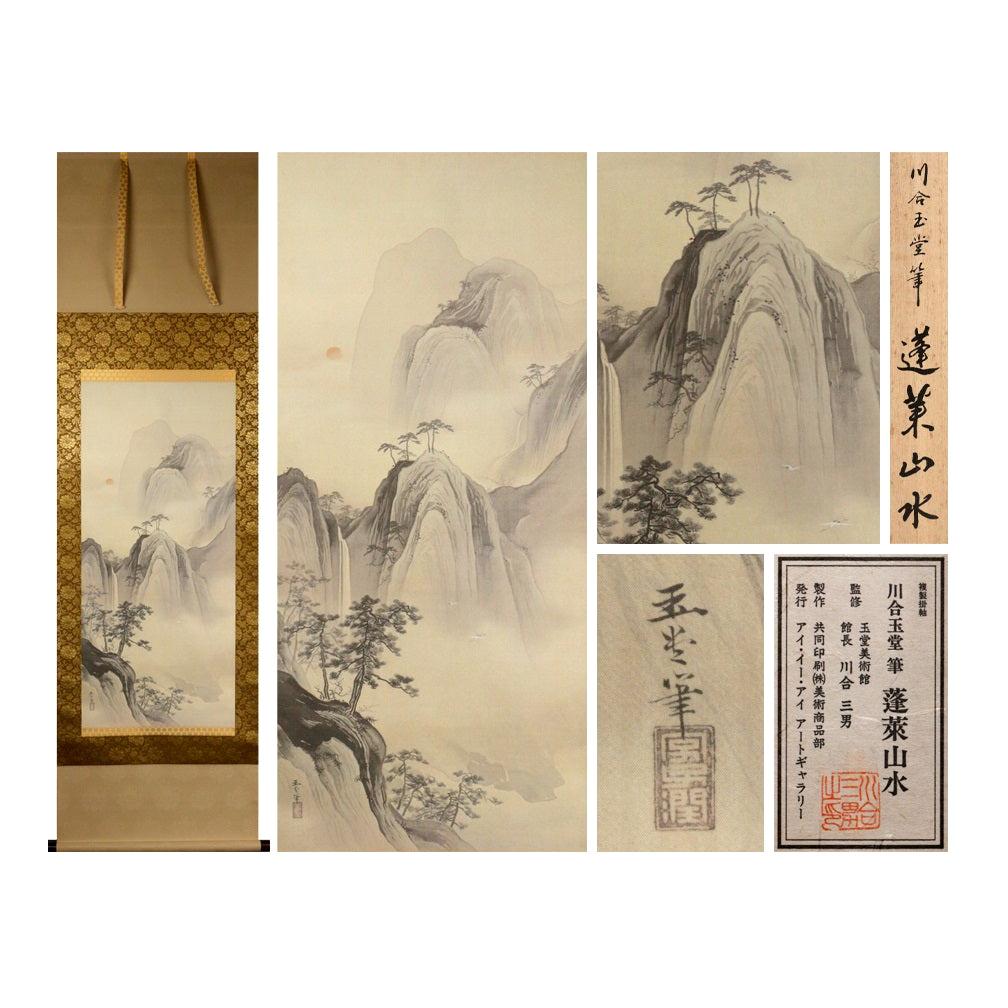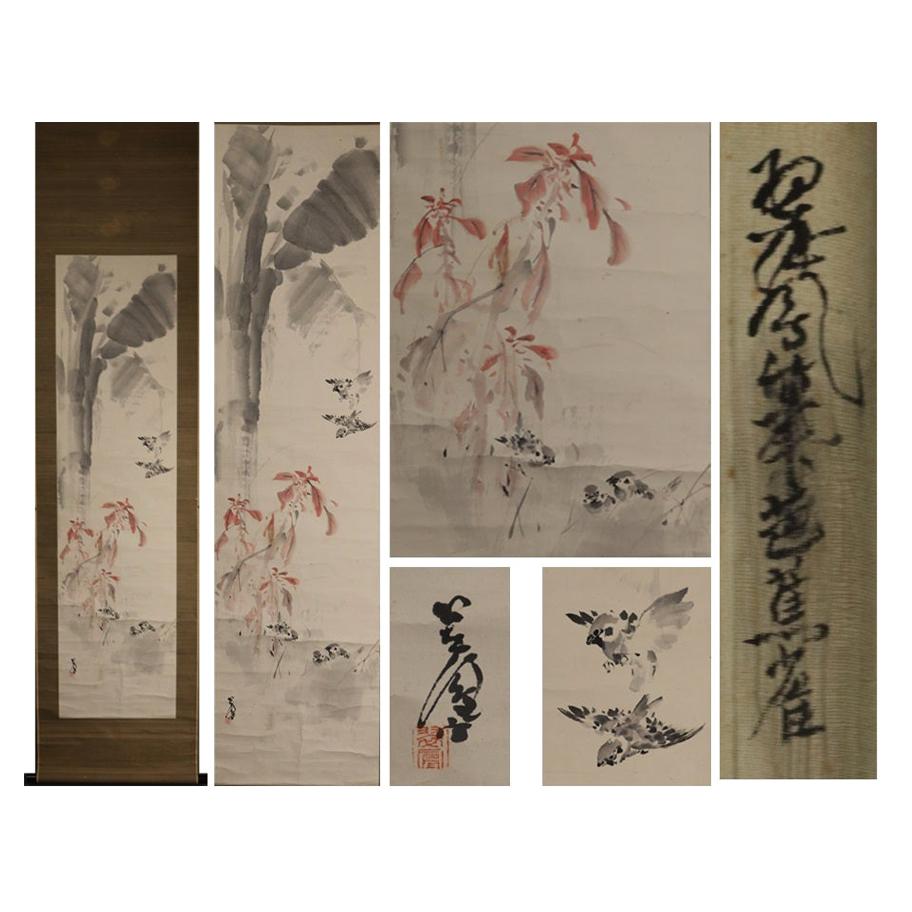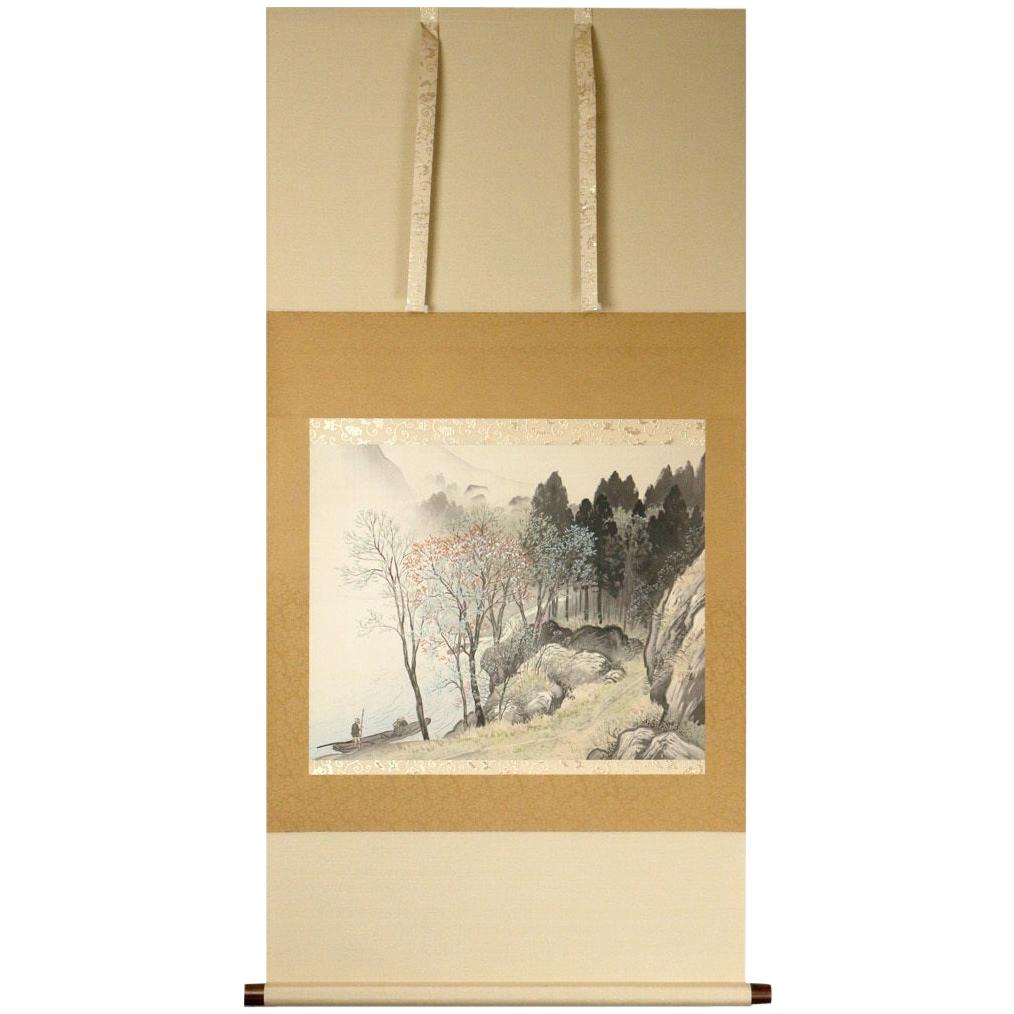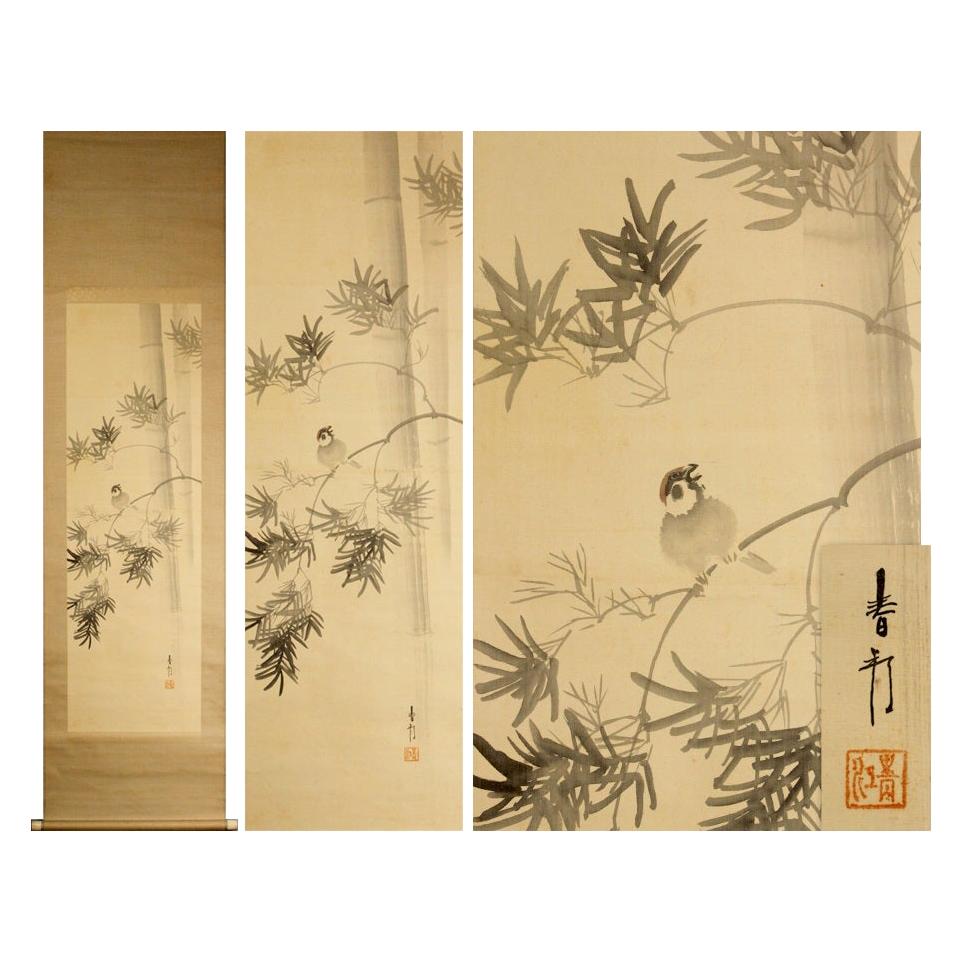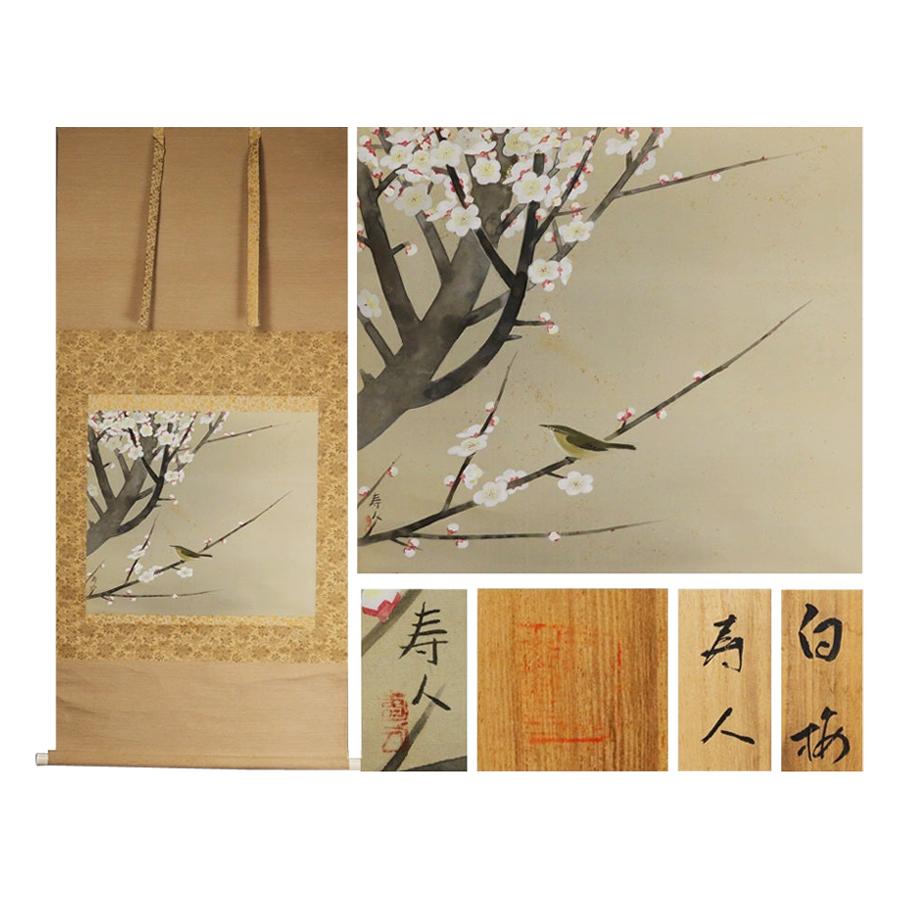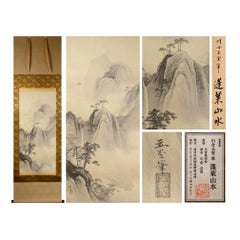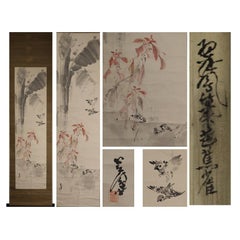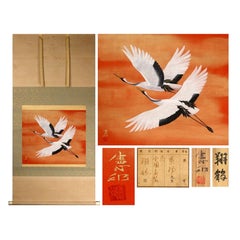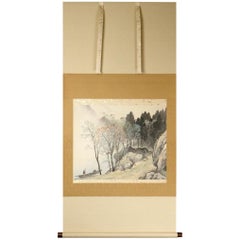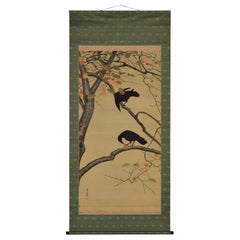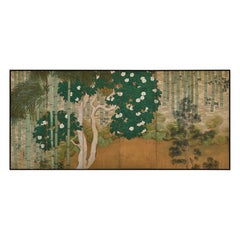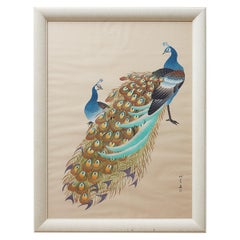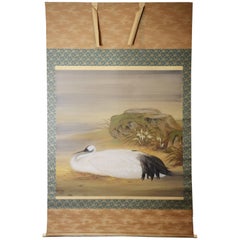Items Similar to Artists Kawai Gyokudō Showa Period Scroll Japan 20c Artist Nihonga
Want more images or videos?
Request additional images or videos from the seller
1 of 5
Artists Kawai Gyokudō Showa Period Scroll Japan 20c Artist Nihonga
About the Item
Kawai Gyokudo (?? ??, November 24, 1873-June 30, 1957) was the pseudonym of a Japanese painter in the Nihongo school, active from Meiji through Showa period Japan. His real name was Kawai Yoshisaburo.
Contents
Biography
Gyokudo was born in what is now Ichinomiya city, Aichi Prefecture, as the eldest son of a paper, ink and brush merchant. He went to Kyoto in 1887 to study under Kono Bairei of the Maruyama-Shijo school of painting. In 1896, he moved to Tokyo and he became the student of Hashimoto Gaho, of the Kano school. He also studied Western-style painting and developed a highly personal style, especially in the field of landscape painting.
Gyokudo is noted for his polychrome and occasionally monochrome works depicting the mountains and rivers of Japan in the four seasons, with humans and animals shown as part of the natural landscape. Among his representative works are Futsuka zuki (“The New Moon”), Yuku haru (“The Departing Spring”), Mine-no-yu (“Evening at the Mountain Top”), and Bosetsu (“Snow in the Evening”).
In 1898, Gyokudo joined with Okakura Tenshin and Yokoyama Taikan to found the Nihon Bijutsuin (Japan Fine Art Academy). In 1907, Gyokudo was selected as a judge for the first annual Bunten Exhibition. He became a teacher at the Tokyo Bijutsu Gakko (the forerunner of the Tokyo National University of Fine Arts and Music) in 1919.
In 1940, he was awarded the Order of Culture by the Government of Japan.
Most of his works are preserved and displayed at the Gyokudo Art Museum, in Ome, Tokyo.
As you can see, "High-class crafts" Kawai Gyokudo's "Kaki autumn leaves".
It is a simple yet warm "Kaki autumn leaves", and it is
a work in which the details of a private house are carefully drawn.
¦ Silk books and crafts.
¦ Condition
There is me etc.
¦ Shaft dimensions / approx. 136.5 cm x approx. 67.0 cm.
¦ Paper dimensions / approx. 39.0 cm x approx. 52.5 cm.
¦ Signs / There are inscriptions and seals as you can see.
¦ Box / Box.
- Dimensions:Height: 53.75 in (136.5 cm)Width: 26.38 in (67 cm)Depth: 0.04 in (1 mm)
- Style:Taisho (Of the Period)
- Materials and Techniques:
- Place of Origin:
- Period:
- Date of Manufacture:20th Century
- Condition:Wear consistent with age and use. ■ Silk book. ■ The condition is beautiful. ■ Shaft dimensions / approx. 181.0 cm x approx. 53.0 cm. ■ Painting dimensions / approx. 90.0 cm x approx. 40.0 cm. ■ Signs / There are inscriptions and seals as you can see. ■ Box / Box.
- Seller Location:Amsterdam, NL
- Reference Number:Seller: 1330917030031stDibs: LU4863223186722
About the Seller
5.0
Platinum Seller
Premium sellers with a 4.7+ rating and 24-hour response times
Established in 2015
1stDibs seller since 2019
236 sales on 1stDibs
Typical response time: 1 hour
- ShippingRetrieving quote...Shipping from: Amsterdam, Netherlands
- Return Policy
Authenticity Guarantee
In the unlikely event there’s an issue with an item’s authenticity, contact us within 1 year for a full refund. DetailsMoney-Back Guarantee
If your item is not as described, is damaged in transit, or does not arrive, contact us within 7 days for a full refund. Details24-Hour Cancellation
You have a 24-hour grace period in which to reconsider your purchase, with no questions asked.Vetted Professional Sellers
Our world-class sellers must adhere to strict standards for service and quality, maintaining the integrity of our listings.Price-Match Guarantee
If you find that a seller listed the same item for a lower price elsewhere, we’ll match it.Trusted Global Delivery
Our best-in-class carrier network provides specialized shipping options worldwide, including custom delivery.More From This Seller
View AllArtists Kawai Gyokudō Showa Period Scroll Japan 20c Artist Nihonga
Located in Amsterdam, Noord Holland
Kawai Gyokudo (?? ??, November 24, 1873-June 30, 1957) was the pseudonym of a Japanese painter in the Nihongo school, active from Meiji through Showa period Japan. His real name was Kawai Yoshisaburo.
Contents
Biography
Gyokudo was born in what is now Ichinomiya city, Aichi Prefecture, as the eldest son of a paper, ink and brush merchant. He went to Kyoto in 1887 to study under Kono Bairei of the Maruyama-Shijo school of painting. In 1896, he moved to Tokyo and he became the student of Hashimoto Gaho, of the Kano school. He also studied Western-style painting and developed a highly personal style, especially in the field of landscape painting.
Gyokudo is noted for his polychrome and occasionally monochrome works depicting the mountains and rivers of Japan in the four seasons, with humans and animals shown as part of the natural landscape. Among his representative works are Futsuka zuki (“The New Moon”), Yuku haru (“The Departing Spring”), Mine-no-yu (“Evening at the Mountain Top”), and Bosetsu (“Snow in the Evening”).
In 1898, Gyokudo joined with Okakura Tenshin and Yokoyama Taikan...
Category
20th Century Japanese Taisho Paintings and Screens
Materials
Silk
$1,849 Sale Price
20% Off
Artists Suiho Yano Showa Period Scroll Japan 20c Artist Nihonga
Located in Amsterdam, Noord Holland
As you can see, it is a work of "Basho / Sparrow" drawn by Midori Yano.
Under Basho, this work skillfully depicts the appearance of sparrows forming a flock and singing food.
«Su...
Category
20th Century Japanese Taisho Paintings and Screens
Materials
Silk
$1,106 Sale Price
20% Off
Artists Norikuni Kawamura, Showa Period Scroll Japan 20c Artist Nihonga
Located in Amsterdam, Noord Holland
As you can see, it is a double box and a box with "Shokakuzu" written by Norikuni Kawamura.
The
"Shokaku-zu", which is composed of graceful textures, spreads its wings and flies, i...
Category
20th Century Japanese Showa Paintings and Screens
Materials
Silk
$1,106 Sale Price
20% Off
Kawai Gyokudō Nihonga Scene Early 20th Century Scroll Painting Japan Artist
Located in Amsterdam, Noord Holland
It is a high-quality craft of the work drawn by Kawai Gyokudo as you can see.
It creates a texture that makes you feel a refreshing breeze, and it is
a tasty work that is carefully drawn even to lush bushes and trees.
(A guidebook (bookmark) is also included.)
"Kawaai Gyokudo"
[1873-1957] Japanese painter. Born in Aichi.
His real name is Hosaburo. Another issue, Ikuan.
At the beginning, he studied under the Shijo school and then Masakuni Hashimoto to study the Kano school, and established
his own style as a moderate landscape painting full of poetry.
Received the Order of Culture. Work "Ayaame" etc.
¦ Paper books and crafts.
¦ The condition is
beautiful.
¦ Axial dimension/approx. 128.0 cm x 62.0 cm.
¦ Paper size/approx. 40.5 cm x 51.0 cm.
¦ Incorporation/There are inscriptions/incorporations as you see.
¦ Box/Box.
awai Gyokudo (?? ??, November 24, 1873 – June 30, 1957) was the pseudonym of a Japanese painter in the nihonga school, active from Meiji through Showa period Japan. His real name was Kawai Yoshisaburo.
Contents
Biography
Gyokudo was born in what is now Ichinomiya city, Aichi Prefecture, as the eldest son of a paper, ink and brush merchant. He went to Kyoto in 1887 to study under Kono Bairei of the Maruyama-Shijo school of painting. In 1896, he moved to Tokyo and he became the student of Hashimoto Gaho, of the Kano school. He also studied Western-style painting and developed a highly personal style, especially in the field of landscape painting.
Gyokudo is noted for his polychrome and occasionally monochrome works depicting the mountains and rivers of Japan in the four seasons, with humans and animals shown as part of the natural landscape. Among his representative works are Futsuka zuki (“The New Moon”), Yuku haru (“The Departing Spring”), Mine-no-yu (“Evening at the Mountain Top”), and Bosetsu (“Snow in the Evening”).
In 1898, Gyokudo joined with Okakura Tenshin and Yokoyama Taikan...
Category
Early 20th Century Japanese Taisho Paintings and Screens
Materials
Silk
$2,927 Sale Price
20% Off
Artists Miyao Jujin, Showa Period Bird and Plum Scroll Japan 20c Artist Nihonga
Located in Amsterdam, Noord Holland
As you can see, this work depicts a sparrow in a bamboo grove with sunlight shining through it.
¦ Silk book / handwriting.
¦
There are some discolorations in the state era.
...
Category
20th Century Japanese Showa Paintings and Screens
Materials
Silk
$724 Sale Price
20% Off
Artists Miyao Jujin, Showa Period Bird and Plum Scroll Japan 20c Artist Nihonga
Located in Amsterdam, Noord Holland
As you can see, Hisato Miyao, Okayama Prefecture, wrote "Shiraume" plum and warbler, and comes with a box.
It is a plum and warbler figure expressed in a truly wonderful color, and...
Category
20th Century Japanese Showa Paintings and Screens
Materials
Silk
$724 Sale Price
20% Off
You May Also Like
Early 20th Century Japanese Nihonga Scroll. Crow & Persimmon.
Located in Kyoto, JP
Anonymous.
Crows & Persimmon
Japanese Scroll. Pigments and Ink on Silk.
Dimensions:
Scroll: H. 235 cm x W. 106 cm.
Image: H. 168 cm x W. 86 cm.
Bird and flower paintings are oft...
Category
Early 20th Century Japanese Taisho Paintings and Screens
Materials
Silk
Early 20th Century Japanese Nihonga Screen. Bamboo Forest.
Located in Kyoto, JP
Anonymous
Bamboo Forest
Early Taisho era. Circa 1910-1915.
Six-panel Japanese Screen. Mineral pigment, gofun and ink on silk.
A six-panel Japanese folding screen, painted on silk in...
Category
Early 20th Century Japanese Taisho Paintings and Screens
Materials
Silk
Japanese Showa Period Peacocks Painted on Silk
Located in Rio Vista, CA
Colorful Japanese ink and color on silk Showa painting of a pair of peacocks. Vivid colors and beautiful details with a signature and seal on right side bottom. Framed in a midcentur...
Category
20th Century Japanese Showa Paintings and Screens
Materials
Silk, Plexiglass, Paper, Wood
$1,440 Sale Price
20% Off
Large Antique Japanese Scroll Depicting a Nesting Crane, Taisho Period
Located in Prahran, Victoria
Large and exceptional Japanese hanging scroll with a realistically painted depiction of a nesting crane by Yoshifuji Yoshio, Taisho/Showa perio...
Category
Early 20th Century Japanese Taisho Paintings and Screens
Materials
Paper, Silk
Japan Scroll Painting, Meiji Period
Located in Pasadena, CA
This is a wonderful example of a Meiji Period screen painting of Japanese Tanuki or racoon dogs in a landscape. The Tanuki is considered to be a mythical creature Japanese culture. T...
Category
Antique Late 19th Century Japanese Meiji Paintings and Screens
Materials
Fabric, Paint
$1,850 Sale Price
24% Off
Japanese Antique Hand Painted Playful Swallows Silk Scroll, Taisho Period
Located in South Burlington, VT
A very fine and delicate Japanese antique hand-painted silk scroll of four playful, diving swallows , likely sparrows or warblers, amidst a plumb tree and waterfall, Taisho period.
...
Category
Early 20th Century Japanese Taisho Paintings and Screens
Materials
Silk
Recently Viewed
View AllMore Ways To Browse
Japanese Brush
Japanese Brushes
Arts And Crafts Screen
Springer Scroll
Japanese Silk Painting Ink
Japanese Scroll Box
Japanese Silk Screen Ink
Japanese Screen Kyoto
Japanese Showa Screen
Japanese Silk Art Landscape
Kano School
Japanese Scroll Landscape Painting
Vintage Autumn Leaves
Japanese Silk Screen Scroll
Kyoto Screens
Japanese Brush Painting
Japanese Screen Seasons
Japanese Kano Screen
